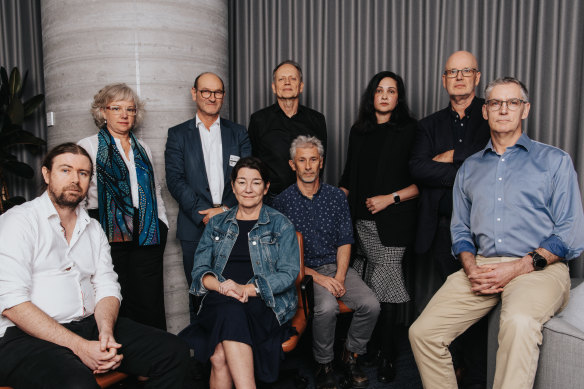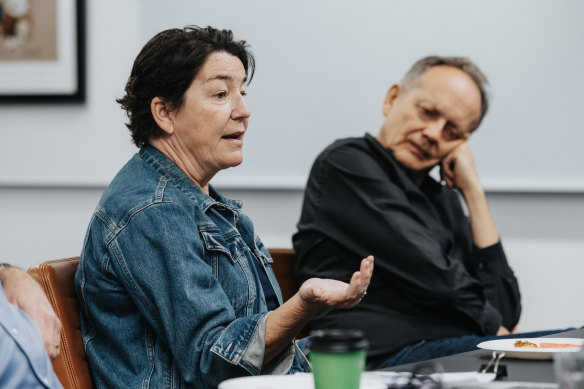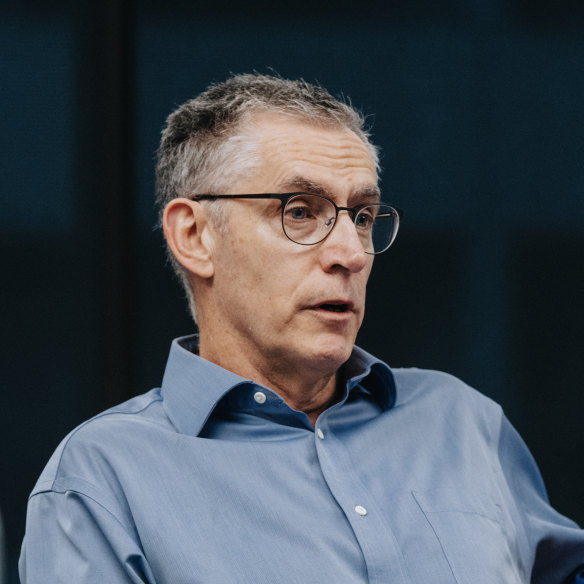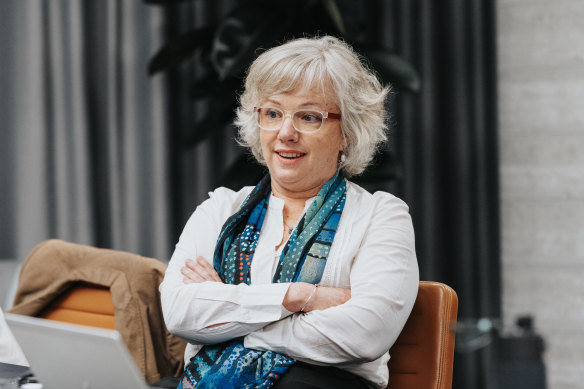This was published 3 months ago
The next pandemic is inevitable. Australia isn’t ready
Top infectious disease and public health veterans at the nerve centre of the state’s war against COVID-19 are sounding the alarm.
By Kate Aubusson and Mary Ward

NSW is less prepared for a pandemic than before the outbreak of COVID-19.Credit: Kate Geraghty, Aresna Villanueva
NSW is less prepared today to fend off a deadly pandemic despite the lessons of COVID-19, say top infectious disease and public health veterans at the nerve centre of the state’s war against the virus.
And we won’t have another hundred years to wait.
NSW’s gold standard Test-Trace-Isolate-Quarantine and vaccination strategies will be useless if a distrusting population rejects directives, refuses to give up its freedoms again, and the goodwill of shell-shocked public health workers dries up.
A panel of experts convened by The Sydney Morning Herald called for a pandemic combat agency akin to the armed forces or fire brigades to commit to greater transparency or risk being caught off guard by the next virulent pathogen and misinformation with the potential to spread faster than any virus.

The Herald’s expert panel, from left: University of Sydney Professor James Wood, University of Sydney Professor Julie Leask, St Vincent’s Hospital Associate Professor Steven Faux, University of Newcastle epidemiologist Jennie Musto, Kirby Institute Scientia Professor Gregory Dore, University of Sydney Professor Nicholas Wood, University of Sydney’s Dr Jocelyne Basseal, University of Sydney Professor Eddie Holmes, University of Newcastle Conjoint Associate Professor Craig Dalton.Credit: James Brickwood
“It’s inevitable,” says Professor Eddie Holmes of the next pandemic. A world-leading authority on the emergence of infectious diseases at the University of Sydney, Holmes predicts: “We’ll have less than 100 years [before the next pandemic].
“We’re seeing a lot of new coronaviruses that are spilling over into animals that humans are interacting with,” said Holmes, the first person to publish the coronavirus genome sequence for the world to see.
“People are exposed all the time, and each time we are rolling the dice.”
The independent review of NSW Health’s response to COVID-19 opened with the same warning: “No health system or community will have the luxury of 100 years of downtime.”
Pandemic preparedness needs to be a “permanent priority”, wrote the report’s author, Robyn Kruk, a former NSW Health secretary, “rather than following the path of those that have adopted a ‘panic and forget strategy,’ allowing system preparedness to wane”.
Why we don’t have 100 years to wait for the next pandemic
The World Health Organisation has declared seven public health emergencies of international concern since 2014, including the current mpox outbreak.
Climate change is turbocharging the factors that coalesce to create the perfect breeding ground for a pandemic-causing virus, including population increases, bigger cities, and better-connected global markets and migration.
“Animals will be forced into more constrained environments, and humans that rely on those environments will be again constrained in the same environments. There will be more wet markets, more live animal trade that will just increase exposure,” Holmes said.
“It was clear that we weren’t ready [for COVID],” said Jennie Musto, who, after seven years working for the World Health Organisation overseas, became NSW Health’s operations manager for the Public Health Emergency Operations Centre, the team responsible for NSW’s COVID-19 contact tracing and containment.
“Everyone had preparedness plans gathering dust on a shelf, but no one was actually ready to respond, and so everyone was on the back foot,” Musto said. “Perhaps none of us really thought this was going to happen. We were waiting 500 years.”

University of Newcastle epidemiologist Jennie Musto and Kirby Institute professor of infectious diseases and epidemiology Greg Dore.Credit: James Brickwood
Who would willingly become the next doomed whistleblower?
Eddie Holmes, known for his repeated assertion that SARS-CoV-2 did not come from a lab, is deeply concerned that when the next pandemic-causing virus emerges, chances are it will be covered up.
“My worry is that if the virus appeared in a small population, say, somewhere in Southeast Asia, the people involved wouldn’t blow the whistle now, given the fact that you would get blamed,” he said.
Li Wenliang, the Wuhan doctor who tried to raise the alarm about a virulent new virus, was reportedly reprimanded by police for spreading rumours and later died of COVID-19.
The global blame game, culminating in a deep distrust of China and accusations that the virus was grown in a Wuhan lab, is why Holmes believes “we’re in no better place than we were before COVID started, if not worse”.
“I work with a lot of people in China trying to keep the lines of communication open, and they’re scared, I think, or nervous about saying things that are perceived to counter national interest.”
From a vaccine perspective, our defences look strong. There have been monumental advancements in vaccine development globally, driven by mRNA technology. In Sydney this month, construction began on an RNA vaccine research and manufacturing facility.
“But the way I see it is that nothing has been done in terms of animal surveillance of outbreaks or data sharing. The [global] politics has got much, much worse,” Holmes said.
Combat force
Conjoint Associate Professor Craig Dalton, a leading public health physician and epidemiologist, called for a dramatic expansion of the public health workforce and the establishment of a pandemic combat force that would routinely run real-time pandemic simulations during “peacetime”.
“No one is upset with fire brigades spending most of the time not fighting fires. They train. A lot. And that’s probably how we need to move,” he said.
“We need exercise training units so that every major player in pandemic response is involved in a real-time, three to four-day pandemic response every three to five years at national, state and local [levels].”
The federal Department of Health and Aged Care recently ran a health emergency exercise focused on governance arrangements involving chief health officers and senior health emergency management officials, a spokeswoman for Health Minister Mark Butler said. The outcomes of this exercise will be tested later this year.
Dalton said desktop simulations and high-level exercises involving a handful of chiefs didn’t cut it, considering the thousands of people working across regions and states. He instead suggested an intensive training program run in the Hunter New England region before the 2009 H1N1 pandemic provided a good model.
“We were ringing people, actors were getting injections, just like a real pandemic,” said Dalton, who once ordered a burrito in a last-ditch effort to contact a restaurant exposed to COVID-19.
Our heroes have had it
The expert panel was emphatic that our pandemic response cannot once again rely on the goodwill of the public health and healthcare workforce.
According to the Kruk review, what began as an emergency response ultimately morphed from a sprint into an ultra marathon and “an admirable (yet unsustainable) ‘whatever it takes’ mindset”.
They were hailed as heroes, but the toll of COVID-19 on healthcare workers was brutal. Workloads were untenable, the risk of transmission was constant, and the risk of violence and aggression (for simply wearing their scrubs on public transport in some cases) was terrifying.
“We got through this pandemic through a lot of people working ridiculous hours,” Dalton said.
“You talk to a lot of people who did that and say they could not do it again.”
Tellingly, several expert personnel who worked at the front lines or in the control centre of NSW’s pandemic defences were invited to join the Herald’s forum but declined. Revisiting this period of intense public scrutiny, culminating in online attacks and physical threats, was just too painful.
So long, solidarity
Arguably, the biggest threat to our pandemic defences will be the absence of our greatest strength during COVID: the population’s solidarity and willingness to follow public health orders even when it meant forfeiting fundamental freedoms.
The public largely complied with statewide public health orders, including the stay-at-home directive that became the 107-day Delta lockdown, and other severe restrictions prevented many from being at the bedside of their dying loved ones, visiting relatives in aged care homes and attending funerals.

Conjoint Associate Professor Craig Dalton from the University of Newcastle. Credit: James Brickwood
“My worry is that next time around when those sorts of rules come out, people may say, ‘Well, don’t worry about it.’ They relax it in the future. Why don’t we just not stick to the rules?” said Professor Nicholas Wood, associate director of clinical research and services at the National Centre for Immunisation Research and Surveillance.
“I’m not sure we quite understand whether people [will be] happy with those rules again,” he said.
Dalton was more strident.
“I tend to agree with Michael Osterholm … an eminent US epidemiologist [who] recently said the US is probably less prepared for a pandemic now than it was in 2019, mostly because the learnings by health departments in the COVID pandemic may not make a material difference if faced with a community that distrusts its public health agencies,” he said.
“If H1N1 or something else were to spill over in the next couple of years, things like masks, social distancing and lockdowns would not be acceptable. Vaccination would be rejected by a huge part of the population, and politicians might be shy about putting mandates in.”
As for the total shutdown of major industries, people will struggle to accept it unless the next pandemic poses a greater threat than COVID, said UNSW applied mathematician Professor James Wood.
The risk of the virus to individuals and their families will be weighed against the negative effects of restrictions, which are much better understood today, said Wood, whose modelling of the impact of cases and vaccination rates was used by NSW Health.
“Something like school closure would be a much tougher argument with a similar pathogen,” he said.
A previous panel of education experts convened by the Herald to interrogate pandemic decision-making in that sector was highly critical of the decision to close schools for months during NSW’s Delta lockdown.
Greg Dore, professor of infectious diseases and epidemiology at the Kirby Institute, said the public’s reluctance to adhere to restrictions again may, in part, be appropriate.
“Some of the restrictions on people leaving the country were a bit feudal and too punitive,” he said. “Other restrictions were plain stupid, [for instance] limitations on time exercising outside.”
Meanwhile, the delays to publicly recognise the benefits of face masks and the threat of airborne transmission “ate away at trust”, Dalton said.
“We shouldn’t make those mistakes again,” he said.
Transparent transgressions
Uncertainty is not something politicians are adept at communicating, but uncertainty is the only constant during a pandemic of a novel virus.
Vaccines that offered potent protection against early iterations of the COVID virus were less effective against Omicron variants.
“[The public], unfortunately, got hit by a rapid sequence of changes of what was ‘true’ in the pandemic,” James Wood said.
Political distrust can be deadly if governments give the public reason to suspect they are obfuscating.
The expert panel urged NSW’s political leaders to be far more transparent about the public health advice they were given before unilaterally enforcing restrictions.
There was a clear line between public health advice and political decision-making in Victoria. The Victorian chief health officer’s written advice was routinely published online.
In NSW, that line was blurred as Chief Health Officer Kerry Chant stood beside political leaders, most notably former premier Gladys Berejiklian, at the daily press conferences.
Public health experts said that they looked for subtle cues to determine the distinction between the expert advice and the political messaging during press conferences, paying attention to body language, who spoke when and who stayed silent.
“It is fine for public health personnel to have a different view to politicians. They have different jobs. What is not OK is to have politicians saying they are acting on public health advice [when they are not],” he said.
The ‘whys’ behind the decisions being made were missing from the daily press conferences, which created “a vacuum for misinformation”, said social scientist and public health expert Professor Julie Leask at the University of Sydney.

Public health and vaccine communication expert Professor Julie Leask from the University of Sydney.Credit: James Brickwood
“The communication about what you need to do came out, and it was pretty good … but the ‘why we’re doing this’ and ‘what trade-offs we’ve considered’ and ‘what dilemmas we’ve faced in making this decision’; that was not shared,” Leask said.
The infodemic
In the absence of transparency, misinformation and disinformation fill the vacuum.
“We had an ‘infodemic’ during the pandemic,” said Dr Jocelyne Basseal, who worked on the COVID-19 response for WHO in the Western Pacific and leads strategic development at the Sydney Infectious Diseases Institute, University of Sydney.
“The public has been so confused. Where do we go for trusted information [when] everyone can now write absolutely anything, whether on Twitter [now called X] or [elsewhere] on the web?” Basseal said.
A systematic review conducted by WHO found misinformation on social media accounted for up to 51 per cent of posts about vaccines, 29 per cent of posts about COVID-19 and 60 per cent of posts about pandemics.
Basseal’s teenage children recently asked whether they were going into lockdown after TikTok videos about the mpox outbreak.
“There is a lot of work to be done now, in ‘peacetime’ … to get ahead of misinformation,” Basseal said, including fortifying relationships with community groups and teaching scientists – trusted and credible sources of information – how to work with media.
In addition to the Kruk review’s six recommendations to improve its pandemic preparedness, NSW Health undertook a second inquiry into its public health response to COVID-19, which made 104 recommendations.
NSW Health Minister Ryan Park said: “We are working hard to ensure the findings and recommendations from those reports are being implemented as quickly as possible.”
The expert panellists spoke in their capacity as academics and not on behalf of NSW Health or WHO.
The ‘As One System’ review into NSW Health’s COVID-19 response made six recommendations
- Make governance and decision-making structures clearer, inclusive, and more widely understood
- Strengthen co-ordination, communication, engagement, and collaboration
- Enhance the speed, transparency, accuracy, and practicality of data and information sharing
- Prioritise the needs of vulnerable people and communities most at risk, impacted and in need from day one
- Put communities at the centre of emergency governance, planning, preparedness, and response
- Recognise, develop and sustain workforce health, wellbeing, capability and agility.
Start the day with a summary of the day’s most important and interesting stories, analysis and insights. Sign up for our Morning Edition newsletter.